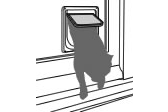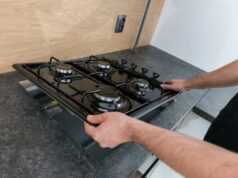
Often it makes sense to attach a small door to your home, not only for your pet’s convenience, but also to save you the trouble of letting then in and out. Find out more about dog doors and cat flaps.

What is a dog door or cat flap?
A dog door or cat flap is a door set into an existing door specifically to allow your cat or dog (or rabbit, or miniature pot-bellied pig) to enter and exit the house at will.
In the case of a cat flap, the door is smaller and is hinged at the top, if at all. In many cases, a cat flap will be just that – a flap of rubber or plastic that the cat can push through.
Dog doors are normally larger, and may be hinged at the side or spring loaded to ensure that they close properly. The door or flap is usually made of a soft plastic to avoid hurting the animal as it passes through. It may also have a tougher plastic slide or some sort of bolt mechanism to lock the door when necessary.
How do dog doors and cat flaps work?
The animal approaches the door and either paws or noses it open to allow passage through. The door then swings closed behind the pet to keep out the wind and rain. In the case of a cat flap, this can mean the flap needs to be weighted to avoid it rattling in the wind, but this can be gotten around by means of a magnetic strip to hold it in place.
Some pet doors may be one way only, to allow the animal to enter but not exit again. This is especially useful for cats that have a tendency to roam.
Where are dog doors and cat flaps used?
Pet doors can be accommodated into just about any existing door type, with a few exceptions (e.g. a stacker door may not close properly with the addition of a pet door). They can even be cut and mounted into sliding glass doors, should the need arise – though this requires a circular portal rather than a square or oblong one to maintain the glass’s strength.
What variations exist in pet doors?
Some pet doors lock when they’re not being used, and open only in response to a specific signal embedded in the pet’s collar (such as an infrared transmitter or electromagnet), while others open in response to a cat’s RFID implant chip. This means only one specific animal has access to your house, and so can prevent access from strays and other unwanted guests.





